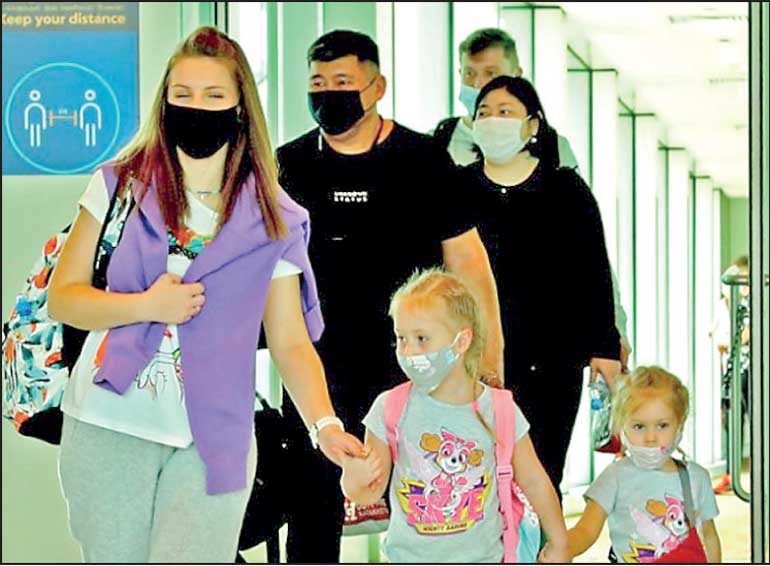Saturday Jan 04, 2025
Saturday Jan 04, 2025
Friday, 14 January 2022 00:09 - - {{hitsCtrl.values.hits}}

By Charumini de Silva
The COVID-hit tourism industry has managed to rebound with earnings of over $ 500 million in 2021. “Tourism holds a greater significance in the services sector and has been a driver of growth for the economy. The industry was the most vulnerable to COVID-pandemic, but it has proven again its resilience with remarkable resurgence. The year ended with 194,495 tourists, with earnings surpassing the target of $ 500 million,” Sri Lanka Tourism Development Authority (SLTDA) Director-General Dhammika Wijayasingha told the Daily FT.
As per provisional data, Sri Lanka finished 2021 with 194,495 tourists, with December attracting 89,506 the highest for a month since the onset of the pandemic in March 2020. India topped the list of countries bringing in the most tourists with 56,268; followed by Russia 16,894, UK 16,646, Germany 12,442, and Ukraine 7,037.
“Sri Lanka Tourism seeks to springboard from recovery to become a more agile and resilient sector. We are optimistic that the industry will continue to grow from 2022 onwards,” Wijayasingha said.
In August 2021, Finance Minister Basil Rajapaksa set a revenue target of $ 500 million for the Tourism Ministry financial year ending in March 2022. However, it seems that the target was met with three months to spare and is all set for a steady growth momentum from this year onwards.
Although full year official data for 2021 is expected in a weeks’ time, tourism earnings as per the Central Bank in the first 11 months was $ 141. 11 million.
Sri Lanka recorded its all-time high of 2.3 million tourists and $ 4.3 billion earnings in 2018. Thereafter, it dropped to 1.9 million in 2019, which marked the year of the Easter Sunday tragedy, followed by the COVID-19 pandemic which brought the industry to a standstill with just 507,704 tourists in 2020.
The Government is pinning hopes on tourism as a low-hanging fruit to boost foreign exchange earnings.
“Sri Lanka aims to attract 2.3 million tourists for this year and aspires to generate an income of $ 4.5 billion for 2022. The key focus to achieve these targets, Sri Lanka is banking on Indian, Middle Eastern and Russian markets, whilst hoping that the traditional markets in Europe will rebound in the latter part of 2022,” Tourism Minister Prasanna Ranatunga told international media covering the Expo 2020 in Dubai on 3 January.
The Government is all set to declare 2022 as ‘Visit Sri Lanka Year’ in line with the integrated five-year Global Communication Campaign (GCC), as its aims for six million tourists and $ 10 billion in earnings by 2025 despite COVID-related challenges.
Over 2021, the Tourism Ministry has taken many steps to formulate a National Tourism Policy for Sri Lanka, and it has now come to the final stages to enact it. Target enforcement date of the national policy as per the Tourism Ministry is by 31 January.
The national roadmap is being developed collaboratively by SLTDA and other UN agencies, including the International Labour Organisation (ILO) and World Tourism Organisation (WTO), development partners such as the World Bank, the Asian Development Bank (ADB), the European Union (EU), the United States Agency for International Development (USAID), Australia and other key stakeholders.
Tourism has been recognised as a thrust sector to rebuild the economy and was identified as an export sector in 2020 and the industry leaders are hopeful of higher arrivals from 2022 onwards, with tourist-friendly health and safety guidelines in place.
The Tourism Ministry recently said a special secretariat will also be established to coordinate the five-year GCC activities, and it will be responsible for the coordination, management and supervision of all the institutions appointed for this purpose.
Previously, such a holistic global promotion program was launched under the leadership of the current Finance Minister Basil Rajapaksa, who then was the Economic Development Minister. The last integrated campaign of Sri Lanka Tourism was carried out during 2008/2009, and no such communication campaigns were carried out since then except a few stand-alone campaigns.
The stakeholders told the Daily FT that an integrated GCC is a dream the tourism industry of Sri Lanka has always had, but was not able to materialise due to many reasons, such as financial barriers, bureaucratic obstacles, lack of competency and the strategic drive to initiate the project.